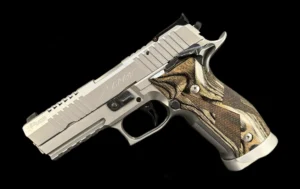Key Takeaways:
- Innovation wasn’t just trendy—it was survival: In 2011, the most innovative firearm manufacturers weren’t just making new products—they were solving real-world problems. SIG Sauer’s modular handguns, Smith & Wesson’s improved triggers, Glock’s polymer resilience—these weren’t gimmicks. They were calculated moves responding to shifting consumer demands and operational realities. If you weren’t innovating with purpose, you were falling behind.
- The economy might’ve been shaky, but demand was rock solid: Even as the global economy wobbled, gun sales surged. Why? Civil unrest, personal safety concerns, and international tension all played a role. First-time buyers flooded the market, and companies like Glock and Smith & Wesson knew precisely how to meet their needs. It wasn’t just about selling guns—it was about reading the room.
- Regulation didn’t just challenge the industry—it sorted the adaptable from the rest: From U.S. debates over gun control to strict EU directives, 2011 wasn’t easy for gun makers legally. However, those who adapted—treating compliance as a business edge rather than a burden—gained significant ground. SIG Sauer’s export savvy and Remington’s nimble product adjustments proved that smart legal navigation was just as crucial as engineering.
Let’s rewind to 2011—a year that, in hindsight, turned out to be a bit of a crossroads for the firearms industry. The world was still recovering from the 2008 financial crash. Economies were slowly recovering, but uncertainty still lingered. And in the middle of all that, the demand for firearms—oddly enough—didn’t stall. In fact, in many ways, it accelerated.
Global tensions, political unrest, and a growing sense of unease at home presented manufacturers with a complex mix of hurdles and opportunities. It wasn’t business as usual. It was business with a sharper edge.
Companies like Smith & Wesson, Glock, Remington, and SIG Sauer didn’t just weather the storm—they adjusted their sails in dramatically different ways. And how they navigated that moment said a lot about where they were headed.
More Than Firepower: Innovation Was the Real Battlefield
If you think 2011 was just about cranking out more guns, think again. That year marked a turning point where innovation meant more than just bigger calibers or new finishes. It was about smarter, safer, and more adaptable firearms.
Smith & Wesson, for one, invested heavily in improving their trigger systems. The result? Safer guns with better performance—something both seasoned shooters and beginners could appreciate. Glock, already a favorite in police departments and security circles, continued to lean into its strength: rugged, polymer-framed pistols that were light, tough, and dependable as ever.
Remington stayed true to its roots but wasn’t idle either. While hunting rifles remained a key focus, the company began experimenting with newer materials to modernize its lineup, especially in the tactical segment. That helped offset a slight decline in interest in traditional hunting.
But SIG Sauer? They went bold. Bold. They rolled out modular handgun systems—something that sounded niche at the time but turned out to be ahead of the curve. Users could tailor the same base firearm for different tasks or environments. It was like giving civilians and professionals alike a LEGO set for grown-up gun owners.
These weren’t just cool gadgets or flashy updates. They were answers to real-world needs. From home defense to military operations, the firearms of 2011 reflected a shift in how people thought about protection, utility, and flexibility.
The Economic Storm Wasn’t Over—But Firearms Kept Selling
Now, here’s the strange part. Even with the global economy still limping along, the firearms market didn’t shrink—it surged. That might seem counterintuitive, but people were anxious. Civil unrest, political uncertainty, and concerns about future regulations prompted many first-time buyers to enter the market. And manufacturers didn’t miss the moment.
Smith & Wesson, already a household name in the U.S., experienced a surge in sales, particularly in its M&P line. Compact pistols were flying off the shelves. Glock maintained its international appeal, relying on its brand’s reliability to stay top of mind for police departments and militaries worldwide.
Remington’s story was a bit more layered. The hunting market, once its bread and butter, was starting to show cracks. However, it adapted, shifting its focus more to tactical shotguns and rifles. That opened the door to new types of customers: individuals seeking something more than just a hunting tool.
SIG Sauer, on the other hand, was playing a different game entirely. They weren’t just aiming for sales—they were aiming for contracts. Their strategy paid off big time with military and law enforcement deals, many of which hinged on the very modular designs they’d just introduced.
This period wasn’t just about numbers. It marked a more profound shift in who was buying firearms and the reasons behind it. And the companies that understood that shift were already laying the foundation for long-term success.
Laws, Loopholes, and the Legal Tightrope
Of course, you couldn’t talk about firearms in 2011 without talking about the legal side of things. It was a year where regulatory pressure ramped up, especially in the U.S., where political debates over gun control were heating up again.
Smith & Wesson and Remington found themselves caught between federal standards and a patchwork of state laws. That meant navigating complex rules about safety features, sales limitations, and even advertising language. It wasn’t easy—and it wasn’t cheap.
Across the Atlantic, Glock and SIG Sauer faced legal challenges. The European Union was tightening firearms directives, prompting updates in production standards and documentation. Compliance wasn’t optional—it was survival.
And then there were export controls. Remember those international deals SIG Sauer was after? They had to navigate the fine line between U.S. regulations and European ones. Any misstep could kill a contract or worse—land the company in hot water.
The ones that handled it well didn’t just play defense. They used it as a chance to set themselves apart. By being faster to comply, more transparent with governments, and more proactive with legal teams, they positioned themselves as reliable partners, not just gun makers.
Forecasts from the Factory Floor
It’s one thing to respond to the moment. It’s another to anticipate what’s coming. And in 2011, every big player in the industry had their theory about where things were headed.
Smith & Wesson and Glock were both betting on continued civilian interest in personal defense weapons. That’s why compact and subcompact models got a lot of attention. And they weren’t wrong—those lines would end up being among their top sellers in the years to come.
Remington placed a more nostalgic bet. It expected a rebound in hunting and outdoor shooting sports and geared its product development that way. While there was some recovery, it didn’t quite match the pace of the booming tactical and self-defense markets.
Then there was SIG Sauer, going all-in on modularity and customization. At the time, it might’ve seemed risky. But looking back, it was brilliant. The concept didn’t just catch on with civilian shooters—it won over military procurement offices, including the U.S. Army. A decade later, that call looks less like a gamble and more like a masterstroke.
These forecasts weren’t just shots in the dark. They were reflections of how each company saw the future. And while not all of them hit the mark, the ones that did are still reaping the rewards.
What 2011 Still Teaches Us
So here we are, looking back more than a decade later, and it’s clear: 2011 wasn’t just another year. It was a hinge point—a moment when the firearms industry had to grow up fast, think smarter, and move quicker.
Every manufacturer faced the same storm, but they didn’t all steer their ships the same way. Some leaned hard into innovation. Others played defense with their legal strategies. A few did both and reaped the rewards.
Smith & Wesson, Glock, Remington, SIG Sauer—they all had different takes on what the moment demanded. Some choices aged better than others. However, each decision left a lasting mark, shaping how the industry evolved throughout the 2010s and into the next era of gun design, regulation, and ownership.
And that’s what makes 2011 worth remembering—not just for the products that came out or the sales numbers posted, but for how it forced the industry to pivot, adapt, and, in many ways, reimagine itself for a new generation of firearm owners.
Frequently Asked Questions
Because everything was shifting at once, the economy was still shaky, political tensions were flaring globally, and more people than ever were buying guns—many for the first time. Manufacturers had to respond fast to changing markets, legal pressure, and a new type of customer who wasn’t necessarily a seasoned shooter. It was one of those rare moments where pressure pushed the industry forward.
A surprising number. Companies stopped just tweaking old designs and started thinking bigger. SIG Sauer’s modular handguns enable users to adapt their pistol for various roles, making it a game-changer. Glock doubled down on lightweight, low-maintenance designs. Smith & Wesson worked on cleaner, safer trigger systems. These weren’t just cosmetic updates—they changed how people used and thought about firearms.
A bit of both, but more help than you’d expect. Although the economy was still in recovery mode, demand for firearms increased, especially in the U.S. A growing sense of uncertainty led to an increased interest in self-defense. That’s why compact pistols were suddenly everywhere. The companies that kept prices accessible while still delivering quality? They cleaned up.












